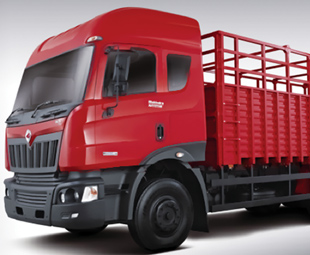Mahindra Navistar rising

In our December review of prospects for the world’s major truck manufacturers, Global Focus commented on the developing joint venture between Navistar International Corporation and Caterpillar, now operational under the imaginative name of NC2 Global LLC, and the rolling out of Navistar’s own joint ventures in India and China.
Mahindra International was established in 2005 to manufacture the entire spectrum of commercial vehicles from 3.5 to 49 t. On 4 January 2010, the re-named Mahindra Navistar Automotives Limited (MNAL) launched its first new products aimed specifically at the Indian market. The initial MN series line-up of rigid trucks and truck-tractors extends from 25 t gross vehicle mass (GVM) to 49 t gross combination mass (GCM), and was developed by Navistar International Corporation in conjunction with MNAL’s India-based engineers. All launch units were assembled in India.
One of the most striking features of this new range is its all-new forward-control cab. With the notable exception of the 7 to 10 t GVM City Star models, Navistar International Corporation’s domestic North American truck range is exclusively of conventional, bonneted-cab configuration. American operators’ preference for this layout has always been an obstacle to United States (US) truck manufacturers’ global marketing aspirations. Many foreign markets are firmly wedded to cab-over configurations, which is clearly reflected in local axle mass legislation, as well as in body-work and trailer-length preferences.
The development of a forward-control cab was considered essential for the success of MNAL products in the Indian market. However, the export potential of vehicles with a cab-over-engine layout did not escape the notice of planners at the emerging Navistar International-Caterpillar/NC2 joint venture company. From a global perspective, the emergence of a modern forward-control cab within the Navistar empire will resonate with the strategic direction being taken by NC2 for its target markets in Australia, Brazil, China, Russia, South Africa and Turkey. Consequently, it would not be surprising if the cab just launched in India were to provide a platform for a much wider set of applications.
The MN 40 and MN 49 – the new series’ heavier models – emerged as 4×2 and 6×4 truck-tractors rated at 40 and 49 t GCM respectively. These derivatives were launched formally at the Auto Expo show which opened in New Delhi on 5 January. Both are powered by Navistar’s 7.2 l MaxxForce CRDI engine, a four-valve-per-cylinder power unit with a 260 hp (194 kW) output. Coupled to a nine-speed synchromesh gearbox, the engine provides grade-abilities of 25.3% for the MN 40 and 22.4% for the MN 49 at rated GCMs. Other common features of these two units include ladder-type chassis frames, tilt and telescopic power steering, full air S-Cam brakes, and optional single-sleeper or double-sleeper cab layouts.
The Mahindra-Navistar range will be expanded over the next two years to include cargo, specialised load and passenger transport vehicles. It is to be manufactured at a new 700-acre greenfield plant located at Chakan, near Pune. Although production was originally planned to begin at the end of 2007, difficulties with the acquisition of Government land for the new plant caused a two-year start-up delay. The first units in the range are now expected to reach domestic customers during March 2010. A key element in the MNAL strategy is the rapid indigenisation of the new range to a level approaching 100% local content. Mahindra Navistar Engines Private Limited (MNEPL), another joint venture involving the same principals, will facilitate this process. MNEPL will manufacture MaxxForce engines on the Chakan site at a planned rate of 40 000 units per annum to power Mahindra Navistar products, and also to supply the automotive and diesel-powered marine transportation markets in India and abroad.
Ashok Leyland’s U-Truck
Another highly significant Indian product range to emerge at Auto Expo 2010 in New Delhi was the Ashok Leyland (AL) U-Truck. After many generations of technical co-operation with other truck manufacturers including the original Leyland Motors, Iveco and Hino Motors, AL has developed this new 25-model range entirely in-house with only some input on engine technology from AVL of Austria. It is intended that the range will eventually replace AL’s current product line-up. Derivatives will cover haulage, tipper and truck-tractor applications across the gross mass spectrum of between16 and 49 t. Much emphasis has been placed on developing modular products that can be customized to a wide range of operators’ individual requirements. AL will be encouraging customers to purchase completely built-up vehicles with bodies, trailers and related special equipment supplied by their state-of-the-art new facility at Pantnagar. The complete U-Truck range is to be rolled out over an 18-month period from April 2010.
A full spectrum of on-road axle/drive configurations will be offered including 4×2, 6×2, 6×4, 8×2 and 8×4. The Newgen suspension-tilt-cab design will be available in standard and high-roof versions, but it came as a surprise to learn that its 2012-2013 replacement, Nextgen, is already on the drawing board. The completely new Neptune engine family provides 11 power-output options covering the 160-360 hp (120-270 kW) range, while higher power-output requirements are to be met by bought-in Cummins or Caterpillar units. AL-built ZF-design gearboxes will cover requirements for six-, eight- or nine-speed transmissions, while 16-speed units will be sourced directly from ZF. Anticipated new developments in automated mechanical and fully-automatic transmissions have been factored into strategic planning for the new product range. Meritor and Dana rear-drive axles are to be sourced from Automotive Axles and Axles India, while other design features include long-span suspension springs for improved ride and optional disc brakes for customers looking for increased safety margins. Service intervals have been set at 40 000 km.
SuperTruck
The US Department of Energy (DOE) is putting up $US 115 million (R871.3 million) for three projects aimed at improving the fuel efficiency of Class Eight 18-wheelers by a margin of 50%. This initiative has the potential to create a new category of Super Truck without compromising prevailing emissions and safety regulations.
Daimler Trucks North America will receive almost $US 40 million (R303 million) of this grant to explore engine down-sizing, the electrification of engine oil and water pumps, waste heat recovery systems, aerodynamics and hybrid drive lines. In partnership with PACCAR-member Peterbilt, Cummins Inc will be provided with nearly $US 39 million (R395.5 million) for the development of a clean and highly efficient diesel engine, an advanced waste heat recovery system, an aerodynamic truck-tractor/semi-trailer combination, and a fuel cell-powered auxiliary unit that can be used as an alternative to allowing a truck’s main diesel engine to idle. In collaboration with Argonne National Laboratories, Navistar International Corporation will use its $US 37.3 million (R282.5 million) portion of the DOE grant to develop technologies for improving truck and trailer aerodynamics, combustion efficiency, waste heat recovery, hybridization, engine idle-time reduction, and reduced tyre rolling resistance.
Using a separate $US 15 million (R113.6 million) grant, Cummins Inc will also work on developing an advanced light-duty vehicle engine that will improve fuel economy by 40% over a conventional petrol engine and significantly surpass the 2010-level EPA emissions requirement. Elements of the programme will include the integration of engine and exhaust after-treatment systems, as well as design developments accommodating on-board diagnostics. Cummins Inc is to employ more than 60 technical personnel in the execution of these light- and heavy-duty vehicle projects.
Volkswagen closes in on MAN
With the dawn of the New Year, reports emerged that Volkswagen (VW) is preparing for a full take-over of German truck-maker MAN Nutzhahrzeuge AG. This follows a two-year period during which VW held a controlling shareholding in MAN and sold its own Brazilian truck and bus operation, Volkswagen Caminhöes e Ônibus, to its German affiliate for €1,175 billion
(R12.4 billion).
Industry analysts were quick to interpret this development as a sign of the impending revival of the 2007 initiative to create a family of truck manufacturers including MAN, Scania of Sweden, and VW Caminhöes. That initiative stalled because of Scania’s resistance to an earlier take-over bid by MAN, and the ensuing acrimonious exchanges that ended only when VW purchased controlling interests in both companies. With MAN now controlling the Brazilian VW operation, the relationship between MAN and Scania is all that remains to be settled. Analysts have suggested that Volkswagen will proceed towards full ownership of MAN by June 2010, increasing its short-term shareholding beyond the present level of just less than 30% by tendering Scania shares as payment. Speculation also has it that – precipitated by the departure of three former top executives, including CEO Håken Samuelsson – recent changes in MAN’s management board will facilitate the process of a merger with Scania, thus bringing all three VW-controlled commercial vehicle manufacturers under a common management umbrella.
Meanwhile, VW is building its relationship with Japanese small-car specialist Suzuki Motor Corporation, the initial phase of which has included the purchase of a 19.9% shareholding in Suzuki. In turn, approximately 50% of the $US 2.53 billion (R19 billion) proceeds of this sale are to be invested in VW. While, to all intents and purposes, both companies will continue functioning independently, the strategic partnership will jointly focus, among other things, on environmentally-friendly compact vehicles and emerging markets. Despite claims by both organisations that a total take-over is not on the cards, any future consolidation of VW and Suzuki assets has the potential to create the world’s largest motor manufacturer boasting nearly 100 global production facilities and more than 420 000 employees. This would certainly be in line with VW’s goal of eventually owning 12 vehicle brands, a target that will move into double figures when it completes its Porsche take-over in 2011.
Combined VW-Suzuki market strength across Japan, Southeast Asia, India, Europe, South America and China could be expanded further to include a more significant North American presence. As positive media and stock market reactions to the announcement of recent developments in the VW-Suzuki relationship confirm, this would place the partnership in a strong position to take the lead globally.
Chinese Cabstar
The latest Nissan Cabstar light truck made its debut in Europe during 2006, subsequently entering the Japanese market as the narrow-cab Atlas-F24 version and materialising in badge-engineered form as the Renault Maxity. Considerable attention has since been paid to the alternative drive line development, as well as to plans for diesel-electric and all-electric versions. The model reportedly dominates the 3.5 t GVM market segment in Europe, while the Atlas derivative model accounts for 20% of the 1.5 t payload segment in Japan.
In the past, Cabstar – more a brand name than a product – was the jealously-guarded, exclusive property of Nissan Motor Company (NMC). Some vehicles carrying the name were built for NMC by its affiliate, Nissan Diesel Motor Company (NDMC); others were manufactured by Isuzu Motors Limited. Following some tricky internecine negotiations during the 1990s, authority was finally given for the sale of a Nissan Diesel Cabstar in South Africa, which may well be the only country in the world where this form of branding was ever allowed. Nissan Diesel has marketed the same product elsewhere under its own UD branding.
Since then, both NMC and NDMC have been absorbed into a global alliance headed by Renault. Together with Renault, NMC focuses on light vehicle manufacturing, while NDMC has been integrated into a Volvo-led commercial vehicle group where attention is fixed firmly on the heavier truck categories. NMC recently announced its intention to more effectively exploit the global light truck niche-market, seeking to double its light commercial-derived income by 2012.
The latest news is that production of a model badged as Cabstar NT400 has begun in China at Zhengzhou Nissan Automobile Company Limited, a Dongfeng subsidiary. The NT 400 has GVM ratings ranging from 3 940 kg to 5 380 kg, and is powered by a locally-manufactured Euro 3-compliant 2.93 l Nissan ZD30DTi inter-cooled common-rail 103 kW diesel engine. It is offered in single- and double-cab configurations, with wheelbase lengths of 2.52, 2.85 and 3.35 m. The total Cabstar line-up now appears to cover the entire global market for light forward-control (cab-over) diesel-powered trucks from 1.5 to 5.4 t GVM, with cab widths of 1.85 and 1.7 m. The European versions are being manufactured at Nissan Motor Iberica in Spain, and offer power options of up to
150 hp (112 kW).
The positioning of this latest Cabstar family at GVM ratings below 5.4 t may present interesting challenges in markets such as South Africa, with its appetite for trucks in the 6 to 8.5 t GVM classes. Given its new orientation, Nissan Diesel is unlikely to pay much attention to this category, while Renault’s European product line-up tends to favour integral panel van-derived models. Nissan’s historic practice of procuring product from Isuzu Motors when it was unable to source suitable models in-house could be one way forward, although Isuzu may well baulk at supplying a powerful competitor in markets where its own distributors are fighting for increased market share. The Dongfeng organisation’s policy of continuing to build older NDMC models at joint venture companies in China may present an interesting alternative.
Global FOCUS is a monthly update of international news relating to the commercial vehicle industry. It is compiled exclusively for FOCUS by Frank Beeton of Econometrix.
Published by
Focus on Transport
focusmagsa




